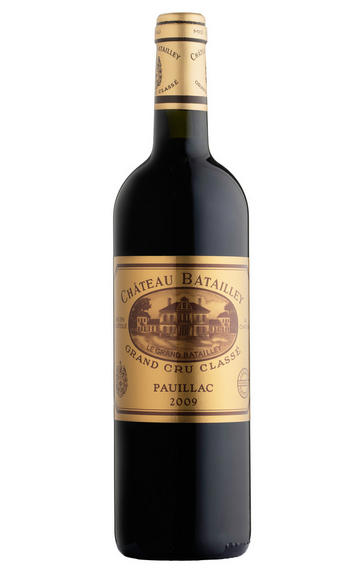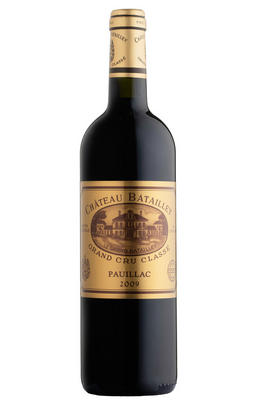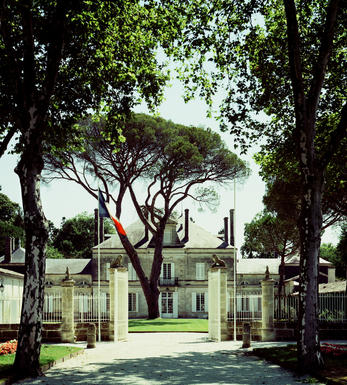
2009 Château Batailley, Pauillac, Bordeaux

Critics reviews
The 2009 Batailley seems a little closed on the nose at first and needs more encouragement than its peers, eventually unfurling with cedar and graphite-infused black fruit, slightly earthy in style. The palate is medium-bodied with fine definition, quite linear and poised with a touch of cracked black pepper on the finish. Excellent.
Drink 2020 - 2038
Neal Martin, Vinous.com (March 2019)
Inky ruby. Red fruits, liquorice, dried herbs and cedary oak on the nose. Then dense and fine-grained in the mouth, with a distinctly cool quality to the blackcurrant jelly, red cherry and candied violet flavours. This rich, smooth wine boasts a lovely depth of flavour and finishes with a strong herbal aftertaste and mounting, mouthcoating tannins. A very successful Batailley to forget about in your cellar for 6 to 8 years, and then enjoy for another 15 to 20 after that.
Ian D'Agata, Vinous.com (May 2010)
Ideal with a 2-hour carafe
This is one of my secret weapon wines, that I know will make everybody happy when it is served. Signature Pauillac, generous but still with muscular tannins, loaded up with pencil lead, slate, cassis, cedar and mint leaf, with waves of liquorice and rose aromatics that keep you coming back for more. Ready to drink but with life ahead of it.
Drink 2022 - 2036
Jane Anson, JaneAnson.com (November 2022)
The finest Batailley I have had in many years, the dense purple-coloured 2009 exhibits a boatload of tannin as well as sweet, caramelized, black currant fruit intermixed with hints of charcoal, cedarwood and smoke, a full-bodied mouthfeel and the aforementioned high, but sweet, well-integrated tannin displaying no jaggedness. Batailley often requires considerable patience as it can be one of the longest-lived Pauillacs. Atypically for Batailley, the 2009 should be ready to drink in 5-7 years and keep for three decades.
Drink 2017 - 2047
Robert M. Parker, Jr., Wine Advocate (December 2011)
Earthy, mushroomy, truffley notes on the nose, as well as stewed bramble fruits and a fine vein of leafy character too. Quite understated in terms of its flavour range – perhaps only just reaching its drinking window.
Drink 2019 - 2029
Richard Hemming MW, JancisRobinson.com (May 2019)
A rich yet dry Pauillac that's now very attractive to drink and has a good harmony in spite of the generous alcohol. Long, supple finish.
Drink or hold
James Suckling, JamesSuckling.com (March 2019)
Rich, rewarding, deep aroma of ripe black fruit. Good natural fruit and middle sweetness with tannins well hidden beneath layers of satiny, luscious fruit. Suspect this is closing up now and it needs a good few years to unfurl.
Drink now to 2040
Stephen Brook, Alun Griffiths MW, Steven Spurrier, Decanter.com
About this WINE

Château Batailley
Château Batailley is one of the oldest estates in Bordeaux, dating from the 15th century. A 5ème Cru Classé, it is known for producing wines of consistently high quality and excellent value in a classic Pauillac style.
The vineyard sits on a plateau at the southern end of Pauillac, on the site of a battle between the French and the English during the Hundred Years War – hence the name ‘Batailley’. The estate has been owned by the Borie family since 1932, and is currently in the hands of family-members Denise and Emile Castèja of the famous negociants Borie-Manoux, which also owns Ch. Lynch-Moussas, Ch. Trotte Vieille and Domaine de l’Église. Ch. Batailley, considered to be the jewel in the family crown, is now managed by son Philippe Castèja and grandson Frédéric.
For years, Ch. Batailley has enjoyed a reputation as a reliable, well-priced Pauillac. Over the last 15-20 years, however, there has been a much greater emphasis on the quality of the fruit. The result has been wines of decidedly more finesse – still in the classic Pauillac style, and still one of the best value Cru Classé at any level.
Since 2014, Batailley has produced a second wine, Lions de Batailley, using grapes from some of the younger vines; it’s lighter in style but retains the signature profile of the Grand Vin.
The 57 hectares of vineyards are planted in classic Pauillac proportions: 70% Cabernet Sauvignon, 25% Merlot, 3% Cabernet Franc and 2% Petit Verdot. The deep gravel beds are ideal for the later-ripening Cabernet Sauvignon; the clay and limestone subsoil is equally favourable to Merlot. Grapes are harvested by hand, in parcels of roughly one hectare each.
Grapes are fully de-stemmed, then fermented in stainless steel tanks. Malolactic fermentation takes place partly in tank, partly in barrel, and the wine is then aged in 225-litre barriques, 55% new, for 16-18 months before bottling.

Pauillac
Pauillac is the aristocrat of the Médoc boasting boasting 75 percent of the region’s First Growths and with Grand Cru Classés representing 84 percent of Pauillac's production.
For a small town, surrounded by so many familiar and regal names, Pauillac imparts a slightly seedy impression. There are no grand hotels or restaurants – with the honourable exception of the establishments owned by Jean-Michel Cazes – rather a small port and yacht harbour, and a dominant petrochemical plant.
Yet outside the town, , there is arguably the greatest concentration of fabulous vineyards throughout all Bordeaux, including three of the five First Growths. Bordering St Estèphe to the north and St Julien to the south, Pauillac has fine, deep gravel soils with important iron and marl deposits, and a subtle, softly-rolling landscape, cut by a series of small streams running into the Gironde. The vineyards are located on two gravel-rich plateaux, one to the northwest of the town of Pauillac and the other to the south, with the vines reaching a greater depth than anywhere else in the Médoc.
Pauillac's first growths each have their own unique characteristics; Lafite Rothschild, tucked in the northern part of Pauillac on the St Estèphe border, produces Pauillac's most aromatically complex and subtly-flavoured wine. Mouton Rothschild's vineyards lie on a well-drained gravel ridge and - with its high percentage of Cabernet Sauvignon - can produce (in its best years) Pauillac's most decadently rich, fleshy and exotic wine.
Latour, arguably Bordeaux's most consistent First Growth, is located in southern Pauillac next to St Julien. Its soil is gravel-rich with superb drainage, and Latour's vines penetrate as far as five metres into the soil. It produces perhaps the most long-lived wines of the Médoc.
Recommended Châteaux
Ch. Lafite-Rothschild, Ch. Latour, Ch. Mouton-Rothschild, Ch. Pichon-Longueville Baron, Ch. Pichon Longueville Comtesse de Lalande, Ch. Lynch-Bages, Ch. Grand-Puy-Lacoste, Ch, Pontet-Canet, Les Forts de Latour, Ch. Haut-Batailley, Ch. Batailley, Ch. Haut-Bages Libéral.

Cabernet Sauvignon Blend
Cabernet Sauvignon lends itself particularly well in blends with Merlot. This is actually the archetypal Bordeaux blend, though in different proportions in the sub-regions and sometimes topped up with Cabernet Franc, Malbec, and Petit Verdot.
In the Médoc and Graves the percentage of Cabernet Sauvignon in the blend can range from 95% (Mouton-Rothschild) to as low as 40%. It is particularly suited to the dry, warm, free- draining, gravel-rich soils and is responsible for the redolent cassis characteristics as well as the depth of colour, tannic structure and pronounced acidity of Médoc wines. However 100% Cabernet Sauvignon wines can be slightly hollow-tasting in the middle palate and Merlot with its generous, fleshy fruit flavours acts as a perfect foil by filling in this cavity.
In St-Emilion and Pomerol, the blends are Merlot dominated as Cabernet Sauvignon can struggle to ripen there - when it is included, it adds structure and body to the wine. Sassicaia is the most famous Bordeaux blend in Italy and has spawned many imitations, whereby the blend is now firmly established in the New World and particularly in California and Australia.


Buying options
Add to wishlist
Description
Bright and ripe dark fruit on the nose, nice depth there. Better still on the palate, ripe fruit, notes of graphite and spice, pleasing and giving, surprisingly crisp acidity, given the ripeness, keeps this in balance, along with ripe, melting tannins. Showing very well now, this will continue to give pleasure for many years to come. A real pleaser of a Ch. Batailley.
Drink 2023 - 2030+
Chris Pollington, Senior Account Manager, Berry Bros. & Rudd
wine at a glance
Delivery and quality guarantee